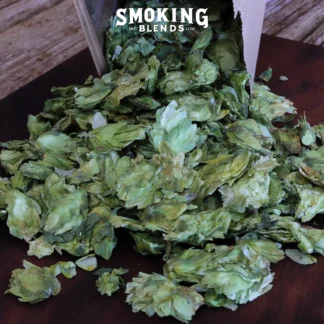Description
Lobelia also known as Indian Tobacco contains no tobacco or nicotine but has a history of use as a smoking herb dating back at least a century. It was used in smoking cessation products until 1993, when the FDA concluded it was not effective. However, some herbal health practitioners still believe it may provide some benefit. The main active compound in lobelia inflata leaves is lobeline. Taken in low doses, it may act as an energizer, and in higher doses, as a relaxant (1).
Lobelia is not a habit-forming herb and is currently used in products that ease the symptoms of nicotine withdrawal. It is also said to possibly have antidepressant characteristics, so it may interfere with medications such as antidepressants or anti-anxiety agents (2). More scientific research and study is needed.
Botanical name: Lobelia Inflata
Plant family: Lobeliaceae
Also called: Indian Tobacco, Eyebright, Asthma Weed, Bladderpod, Puke Weed, Gagroot and Vomitroot.
Identification
Lobelia inflata is distinguished from other strains and plants by it’s small, 1/3-inch long, tubular, bright white or pale blue flowers that have two lobes on the upper lip and three slightly larger lobes on the lower lip, the calyx of the flower that has five narrow, spiky lobes and its inflated fruit. The leaves are hairy and toothed and grow between 2 and 3 inches in length and three quarters to one and a half inches wide. The small, globular fruit grows to be around one-third of an inch wide and produces many very small golden brown oval seeds that can be carried by the wind. The Latin name inflata comes from its “inflated” fruit (1).
Habitat
Lobelia inflata grows wild in the US and Southern Canada. It does best in loamy clay or rocky soil, prefers partial sun and can be found in open woods, fields, and roadsides.
Uses
Lobelia Tea
Lobelia tea is mild-tasting, but can cause a strange sensation in the throat. When using lobelia as tea, it is recommended that someone start with a small amount and gradually increase the dose to their desired level. Do not over consume lobelia tea.
Because lobelia (puke weed) in larger amounts can cause nausea and has been used to induce vomiting by herbal health practitioners, it is not recommended for people who are pregnant, nursing, have existing health problems or are currently taking medications. Lobelia may not be recommended for long-term use.
How to Make Lobelia Tea
Try starting out with half a gram of lobelia per 16 oz of water. Slow boil the leaf in the water for at least 4 minutes, allow it to cool, and strain out the remaining material. If you would like a stronger or weaker tea, you can increase or decrease the amount of leaf used and the amount of time it is boiled in very small increments. Do not consume too much lobelia tea at once or directly consume the leaves.
Smoking Lobelia
When smoked, lobelia is mildly harsh and of average flavor; it is often used in tobacco-free smoking mixtures. It can be smoked in any device, including vapes and rolled for herbal smokes. The leaf of lobelia is most often used for smoking.
Lobelia as Smudge
While Lobelia is valued in herbal medicine for its potential therapeutic benefits, its use in smudging rituals is not a common or traditional practice.
Herbal Supplement
Lobelia has a very long history of use in herbal supplements and by natural health practitioners. It is recommended that anyone using lobelia for herbal supplementation do so under the direction of a natural health practitioner.
This material is meticulously processed and cleaned by hand. Please take a look at our Hand Processing Herbs page for more information.







Reviews
There are no reviews yet.